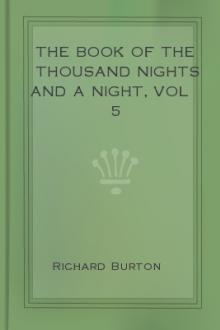The Book of the Thousand Nights and a Night, vol 5 by Sir Richard Francis Burton (red novels txt) 📖

- Author: Sir Richard Francis Burton
- Performer: -
Book online «The Book of the Thousand Nights and a Night, vol 5 by Sir Richard Francis Burton (red novels txt) 📖». Author Sir Richard Francis Burton
[FN#467] A theologian of Bassorah (eighth century): surnamed Ab�
Yahy�. The prayer for mercy denotes that he was dead when the tale was written.
[FN#468] A theologian of Bassorah (eighth century).
[FN#469] Arab. “Musall�”; lit. a place of prayer; an oratory, a chapel, opp. to “J�mi’” = a (cathedral) mosque.
[FN#470] According to all races familiar with the negro, a calf like a shut fist planted close under the ham is, like the “cucumber shin” and “lark heel”, a good sign in a slave. Shapely calves and well-made legs denote the idle and the ne’er-do-well.
I have often found this true although the rule is utterly empirical. Possibly it was suggested by the contrast of the nervous and lymphatic temperaments.
[FN#471] These devotees address Allah as a lover would his beloved. The curious reader will consult for instances the Dabistan on Tasawwuf (ii. 221; i.,iii. end, and passim).
[FN#472] Arab. “Ma’rifat,” Pers. D�nish; the knowledge of the Truth. The seven steps are (1) Shar�‘at, external law like night; (2) Tar�kat, religious rule like the stars; (3) Hak�kat, reality, truth like the moon; (4) Ma’arifat like the sun; (5) Kurbat, proximity to Allah; (6) Was�lat, union with Allah, and (7) Suknat, dwelling in Allah. (Dabistan iii.29.) [FN#473] Name of a fountain of Paradise: See Night xlix., vol.
ii., p.100.
[FN#474] Arab. “Atb�k”; these trays are made of rushes, and the fans of palm-leaves or tail-feathers.
[FN#475] Except on the two great Festivals when fasting is forbidden. The only religion which has shown common sense in this matter is that of the Guebres or Parsis: they consider fasting neither meritorious nor lawful; and they honour Hormuzd by good living “because it keeps the soul stronger.” Yet even they have their food superstitions, e.g. in Gate No. xxiv.: “Beware of sin specially on the day thou eatest flesh, for flesh is the diet of Ahriman.” And in India the Guebres have copied the Hindus in not slaughtering horned cattle for the table.
[FN#476] Arab. “Jall�biyah,” a large-sleeved robe of coarse stuff worn by the poor.
[FN#477] His fear was that his body might be mutilated by the fall.
[FN#478] The phrase means “offering up many and many a prayer.”
[FN#479] A saying of Mohammed is recorded “Al-fakru fakhr�”
(poverty is my pride!), intelligible in a man who never wanted for anything. Here he is diametrically opposed to Ali who honestly abused poverty; and the Prophet seems to have borrowed from Christendom, whose “Lazarus and Dives” shows a man sent to Hell because he enjoyed a very modified Heaven in this life and which suggested that one of the man’s greatest miseries is an ecclesiastical virtue—“Holy Poverty”—represented in the Church as a bride young and lovely. If a “rich man can hardly enter the kingdom” what must it be with a poor man whose conditions are far more unfavourable? Going to the other extreme we may say that Poverty is the root of all evil and the more so as it curtails man’s power of benefiting others. Practically I observe that those who preach and praise it the most, practise it the least willingly: the ecclesiastic has always some special reasons, a church or a school is wanted; but not the less he wishes for more money. In Syria this Holy Poverty leads to strange abuses. At Bayrut I recognised in most impudent beggers well-to-do peasants from the Kasraw�n district, and presently found out that whilst their fields were under snow they came down to the coast, enjoyed a genial climate and lived on alms. When I asked them if they were not ashamed to beg, they asked me if I was ashamed of following in the footsteps of the Saviour and Apostles. How much wiser was Zoroaster who found in the Supreme Paradise (Minuw�n-minu) “many persons, rich in gold and silver who had worshipped the Lord and had been grateful to Him.” (Dabistan i.
265.)
[FN#480] Koran vii. 52.
[FN#481] Arab. “Al-bayt” = the house. The Arabs had probably learned this pleasant mode of confinement from the Chinese whose Kea or Cangue is well known. The Arabian form of it is “Ghull,”
or portable pillory, which reprobates will wear on Judgment Day.
[FN#482] This commonest conjuring trick in the West becomes a miracle in the credulous East.
[FN#483] Arab. “K�n�n”; the usual term is Mankal (pron. Mangal) a pan of copper or brass. Some of these “chafing-dishes” stand four feet high and are works of art. Lane (M.E. chapt. iv) gives an illustration of the simpler kind, together with the “Azik�,” a smaller pan for heating coffee. See Night dxxxviii.
[FN#484] See vol. iii., p.239. The system is that of the Roman As and Unciae. Here it would be the twenty-fourth part of a dinar or miskal; something under 5d. I have already noted that all Moslem rulers are religiously bound to some handicraft, if it be only making toothpicks. Mohammed abolished kingship proper as well as priestcraft.
[FN#485] Al-Islam, where salvation is found under the shade of the swords.
[FN#486] Moslems like the Classics (Aristotle and others) hold the clitoris (Zamb�r) to be the sedes et scaturigo veneris which, says Sonnini, is mere profanity. In the babe it protrudes beyond the labi� and snipping off the head forms female circumcision.
This rite is supposed by Moslems to have been invented by Sarah who so mutilated Hagar for jealousy and was afterwards ordered by Allah to have herself circumcised at the same time as Abraham. It is now (or should be) universal in Al-Islam and no Arab would marry a girl “unpurified” by it. Son of an “uncircumcised” mother (Ibn al-bazr�) is a sore insult. As regards the popular idea that Jewish women were circumcised till the days of Rabbi Gershom (A.D.1000) who denounced it as a scandal to the Gentiles, the learned Prof. H. Graetz informs me, with some indignation, that the rite was never practised and that the great Rabbi contended only against polygamy. Female circumcision, however, is I believe the rule amongst some outlying tribes of Jews. The rite is the proper complement of male circumcision, evening the sensitiveness of the genitories by reducing it equally in both sexes: an uncircumcised woman has the venereal orgasm much sooner and oftener than a circumcised man, and frequent coitus would injure her health; hence I believe, despite the learned historian, that it is practised by some Eastern Jews. “Excision” is universal amongst the negroids of the Upper Nile (Werne), the Som�l and other adjacent tribes. The operator, an old woman, takes up the instrument, a knife or razor-blade fixed into a wooden handle, and with three sweeps cuts off the labia and the head of the clitoris. The parts are then sewn up with a packneedle and a thread of sheepskin; and in Dar-For a tin tube is inserted for the passage of urine. Before marriage the bridegroom trains himself for a month on beef, honey and milk; and, if he can open his bride with the natural weapon, he is a sworder to whom no woman in the tribe can deny herself. If he fails, he tries penetration with his fingers and by way of last resort whips out his whittle and cuts the parts open. The sufferings of the first few nights must be severe. The few Som�li prostitutes who practised at Aden always had the labi� and clitoris excised and the skin showing the scars of coarse sewing. The moral effect of female circumcision is peculiar. While it diminishes the heat of passion it increases licentiousness, and breeds a debauchery of mind far worse than bodily unchastity, because accompanied by a peculiar cold cruelty and a taste for artificial stimulants to “luxury.” It is the sexlessness of a spayed canine imitated by the suggestive brain of humanity.
[FN#487] Koran vi. So called because certain superstitions about Cattle are therein mentioned.
[FN#488] Koran iv. So called because it treats of marriages, divorces, etc.
[FN#489] S�di (contracted from Sayyid� = my lord) is a title still applied to holy men in Marocco and the Maghrib; on the East African coast it is assumed by negro and negroid Moslems, e.g.
Sidi Mub�rak Bombay; and “Seedy boy” is the Anglo-Indian term for a Zanzibar-man. “Khaww�s” is one who weaves palm-leaves (Khos) into baskets, mats, etc.: here, however, it may be an inherited name.
[FN#490] i.e. in spirit; the “strangers yet” of poor dear Richard Monckton Milnes, Lord Houghton.
[FN#491] Al-Hakk = the Truth, one of the ninety-nine names of Allah.
[FN#492] The Moslem is still unwilling to address Sal�m (Peace be with you) to the Christian, as it is obligatory (Farz) to a Moslem (Koran, chapt. iv. and lxviii.). He usually evades the difficulty by saluting the nearest Moslem or by a change of words Allah Yahd�-k (Allah direct thee to the right way) or “Peace be upon us and the righteous worshipers of Allah” (not you) or Al-Samm (for Salam) alayka = poison to thee. The idea is old: Alexander of Alexandria in his circular letter describes the Arian heretics as “men whom it is not lawful to salute or to bid God-speed.”
[FN#493] Koran xxxvi. 82. I have before noted that this famous phrase was borrowed from the Hebrews, who borrowed it from the Egyptians.
[FN#494] The story of Moses and Khizr has been noticed before.
See Koran chapt. xviii. 64 et seq. It is also related, says Lane (ii. 642), by Al-Kazw�ni in the Aj�ib al-Makhl�k�t. This must be “The Angel and the Hermit” in the Gesta Romanorum, Tale lxxx.
which possibly gave rise to Parnell’s Hermit; and Tale cxxvii.
“Of Justice and Equity.” The Editor says it “contains a beautiful lesson:” I can find only excellent excuses for “doing evil that good may come of it.”
[FN#495] Koran chapt. v.108.
[FN#496] The doggrel is phenomenal.
[FN#497] He went in wonder and softened heart to see the miracle of saintly affection.
[FN#498] In Sufistical parlance, the creature is the lover and the Creator the Beloved: worldly existence is Disunion, parting, severance; and the life to come is Reunion. The basis of the idea is the human soul being a divin� particula aur�, a disjoined molecule from the Great Spirit, imprisoned in a jail of flesh; and it is so far valuable that it has produced a grand and pathetic poetry; but Common Sense asks, Where is the proof? And Reason wants to know, What does it all mean?
[FN#499] Koran xiii. 41.
[FN#500] Robinson Crusoe, with a touch of Arab prayerfulness.
Also the story of the Knight Placidus in the Gesta (cx.), Boccaccio, etc.
[FN#501] Arabs note two kinds of leprosy, “Bahak” or “Baras” the common or white, and “Juzam” the black leprosy; the leprosy of the joints, mal rouge. Both are attributed to undue diet as eating fish and drinking milk; and both are treated with tonics, especially arsenic. Leprosy is regarded by Moslems as a Scriptural malady on account of its prevalence amongst the Israelites who, as Manetho tells us, were expelled from Egypt because they infected and polluted the population. In medi�val Christendom an idea prevailed that the Saviour was a leper; hence the term “morbus sacer”; the honours paid to the sufferers by certain Saints and the Papal address (Clement III. A.D.1189) dilectis filiis leprosis. (Farrar’s Life of Christ, i.149.) For the “disgusting and impetuous lust” caused by leprosy, see Sonnini (p.560) who visited the lepers at Canea in Candia. He is one of many who describes this symptom; but in the Brazil, where the foul malady still prevails, I never heard of it.





Comments (0)